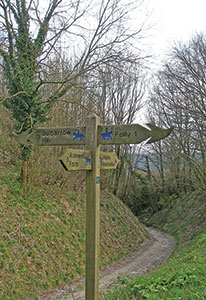A medieval crossroads, a motorway junction from a former time, a secret spot, a time/space vortex, a geological oddity. These are some of the descriptions of the Dorsetshire Gap, a curious conjunction of ancient trackways and chalk landscape deep in rural Dorset.
The Dorsetshire Gap is a special and unusual place. Buried in mid-Dorset countryside between Ansty and Folly, it is at least a mile from even minor roads and accessible only on foot. I first came here more than twenty years ago and since then I have been unable to resist the periodic lure of this spot. Earlier this year, under a cloudless, sapphire-blue sky, we approached from the East along a chalk ridge clothed in rough grass and purple punctuations of knapweed and thistles. Encouraged by the midsummer heat, butterflies and bees flitted purposefully between wild flowers and we admired the long, green view northwards over the Blackmore Vale.
Eventually, the path dipped down between trees and through a gate to reveal a flattened clearing, seemingly enclosed by rough woodland and high chalk banks. Looking about, you notice other tracks converging on the same spot from different angles and elevations. One track, from the south, climbs through a clear gap between chalk banks. A prominent four-way signpost gives directions. The Dorsetshire Gap is a complex motorway junction but dating from another age.
Geologically speaking, this remote part of Dorset lies at the northern edge of a broad band of chalk that runs south west across the county from the Wiltshire border. Where the chalk ends, it tilts upwards to form a steep escarpment facing the northern clay. This chalk escarpment provides a natural barrier to north/south passage and the Dorsetshire Gap is a break in this ridge allowing access of tracks from the chalky south to the wet claylands of the Blackmore Vale. Other routes, including ancient Ridgeway tracks from Wiltshire and Devon, converge here so that the Dorsetshire Gap is a crossroads, recognised for centuries, where people and animals moving east/west on the Ridgeway were able to access north/south tracks.
How does a place like this arise? No one really knows; how much is natural and how much is man-made is also in dispute. There are numerous earthworks in the vicinity and the remains of a medieval village in the valley below so human influence seems likely. We do know that the Dorsetshire Gap was an important road crossing from the Middle Ages until the 19th century and the paths coming together here are ancient trackways. Some of these trackways may have been used for the movement of goods by packhorse trains, or for the movement of animals by drovers; these practices stopped only with the advent of the railways. If you follow paths westwards from the Gap towards Folly, you eventually reach the road and an isolated house that was formerly an Inn. According to Ralph Wightman this used to be called the Fox Inn and closed only in the mid 20th century. In the past, this may have been a refuge for travellers on the Ridgeway, including drovers and their animals, providing a safe haven for the night.
Several of the trackways are also sunken lanes where tramping feet, heavy hoofs, scraping wheels and foul weather have, over centuries, worn the soft rock away so that the path now lies below the level of the surrounding countryside. Some call these sunken lanes Holloways and further to the west in Dorset there are some striking examples of very deep Holloways. There is a mystique attached to these sunken paths: they are visible remnants of a wilder time, they provide tangible evidence of long forgotten lives and of older ways of travel. Perhaps because of this mystique, Geoffrey Household, in his 1939 novel “Rogue Male”, has his fugitive hero hide in a deep Holloway in west Dorset. Robert McFarlane has written lyrically about these sunken paths and his unsuccessful quest to find Household’s holloway-hideaway north of Chideock.
So what makes the Dorsetshire Gap a special place, one that people write about, one that people actively seek out, one whose name is even inscribed on Ordnance Survey maps?
I believe this relates to history and to the power of the imagination. The Dorsetshire Gap has been an important crossroads for hundreds of years. It is an important relic of times past and, as we stand here, we can imagine the sights and sounds of past lives: fragments of conversation from chance meetings, clinking harness as animals are driven through, cries for help as people are robbed, people heading quickly for the ancient drovers’ refuge at Folly. The Gap probably hasn’t changed much over the years so when we visit, we can “slip back out of this modern world” (using the words of W.H. Hudson). Perhaps this is why the Gap has its own visitor’s book. According to Priscilla Houston, the book was first put there in 1972 by a writer known as “Valesman” in the hope that this might help preserve the Gap. For many years it was kept in an old biscuit tin, replaced nowadays by a more secure plastic box. The book allows visitors to record their reflections on visiting this very old, very “Dorset” and very special place.
Philip Strange is Emeritus Professor of Pharmacology at the University of Reading. He writes about how science fits in to society, hoping to bridge the gap between science and public understanding of science. His work may be read at http://philipstrange.wordpress.com/








